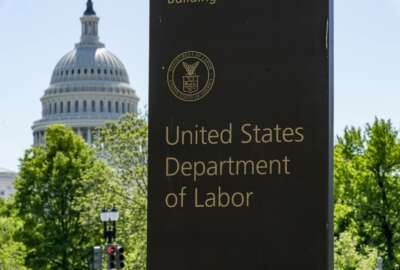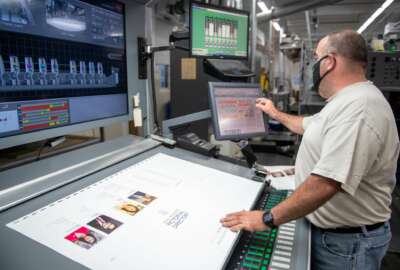

Hubbard Radio Washington DC, LLC. All rights reserved. This website is not intended for users located within the European Economic Area.
The Nevada office of the Bureau of Land Management has so many paper records, they'd probably cover the land the agency manages.
Best listening experience is on Chrome, Firefox or Safari. Subscribe to Federal Drive’s daily audio interviews on Apple Podcasts or PodcastOne.
The Nevada office of the Bureau of Land Management has so many paper records, they’d probably cover the land the agency manages. Recently it awarded multiple contractors a blanket purchase agreement to scan and digitize the paper. For details of how this will all work, the BLM’s Nevada range program lead, Kathryn Dyer, joined the Federal Drive with Tom Temin.
Interview transcript:
Tom Temin: Ms. Dyer, good to have you on.
Kathryn Dyer: Thank you Good to be here,
Tom Temin: Well just give us a scope to kind of set the scene here of what the Nevada office does, how much land it manages, and the scope of the paperwork that you got to deal with.
Kathryn Dyer: So the Nevada State Office supports the six district offices in Nevada. And throughout Nevada, there’s over 43 million acres of BLM-managed land. And so we support the districts in their on-the-ground management — help interpret policy, help allocate the budget, and provide that nexus with the headquarters office,
Tom Temin: And the paperwork that you will eventually digitize, what is the nature of it? What’s it all about? And where does it come from?
Kathryn Dyer: Well, this particular blanket purchase agreement includes only the range records, which I say only loosely, because we have quite extensive extensive records. So we have all the records that are housed in allotment files, permittee files, range improvement files, monitoring files, unauthorized use or trespass files, all the litigation files, as well as the multitude of historic records, such as even adjudication files.
Tom Temin: Got it. So this could go back a century, then, some of the records.
Kathryn Dyer: Absolutely. And that’s one of the benefits of this work. Because currently, the prioritization from some of the offices that are currently taking advantage of this contract opportunity is to get some of the older files digitized, so that then they can be more comfortable packaging those up and sending those off to long-term holding, while still having the information available at their fingertips.
Tom Temin: Got it. And give us a sense of the forms that these take. Are they maps? Are they all 8.5” x 11” sheets? Or what do they look like physically?
Kathryn Dyer: Absolutely everything. And that’s part of the intricacies of the contract, because the four contractors that were awarded the connection to this BPA agreement, they all have to be able to accommodate that variety of different data. And so we have, you know, large maps that are folded up in files, we have those old, I think they call them onion sheets that are really thin paper that you have to be very delicate with. We do have a lot of classic 8.5” x 11” type papers. But really, there’s everything included.
Tom Temin: And do you have acres of — well, I’m exaggerating — but you have lots of file cabinets and lots of weight, sheer physical weight, holding all of this documentation?
Kathryn Dyer: Oh, yes, we have massive, massive amounts of files. So that’s one of the things the offices are excited about is, like I said, you know, once these are digitized, especially the older files, because we will still retain a lot of files at the offices. But the older files we will be able to send away to long term storage. And that will clear up some very valuable space for the offices to use in other ways.
Tom Temin: Because I’ve heard of — maybe these are apocryphal stories — but I’ve heard of file cabinets getting so heavy, they’ve actually endangered structures that federal offices are in. You’re not quite there yet.
Kathryn Dyer: Well, I haven’t heard that. But I do believe it.
Tom Temin: All right, tell us then how this will work. I mean, you’ll have task orders for different classes of papers at different times among the four contractors?
Kathryn Dyer: So each of the task orders, or calls, is the way this particular BPA is set up each of those calls has to be under $250,000 worth of work. And each one is individually bid on by the four connected contractors. And so right now we only have our first call active, but we are already setting up the second and third call to be ready for those. And so we don’t have all the money to do all of the files at once. So that’s the way we’re kind of partitioning the work, so that we can focus on certain offices at a time as the offices have the capacity also to ensure that they can provide the biweekly review of the work and ensure that they’re getting a quality product of digitization along the way.
Tom Temin: We’re speaking with Kathryn Dyer. She’s the Nevada range program lead at the Bureau of Land Management. And I imagine for, say, a given $250,000 or any dollar amount, you can probably get a lot more 8.5” x 11” sheets from the last 10 years done, than you can of ancient maps that might be folded up into odd shapes. So each job is a little bit different technically, then, isn’t it?
Kathryn Dyer: Absolutely. And so that’s what the offices have to do to help us prepare each call is they have to quantify all of these different types of documents that they’re going to need to be scanned and digitized. And so that also influences what different machines, you know, what different scanning capacity each contractor would need to bring to a particular.
Tom Temin: Yea, some would have to be just black and white, and some might have to be full color if you’re dealing with maps.
Kathryn Dyer: Right.
Tom Temin: And let me ask you this: Are you looking for capability to search and otherwise use these documents in digital form, or will they simply be static PDFs? What’s the retrieval mechanism to make sure you can find them again once they’re digitized and stored in Stone Mountain or wherever it is?
Kathryn Dyer: Yeah, no, that’s a great question. We’re absolutely making them searchable PDFs, as well as having naming conventions and electronic file structure that is compatible with our paper file structure. So they will be searchable, usable. You know, everyone working from home for the amount of time that they did during the pandemic — you know, we now have returned to office to some capacity in all of our offices — but that really was an eye opening experience in terms of how desperately we need to be able to have these records in something other than a paper farm.
Tom Temin: Now the Nevada office that you oversee, you mentioned has something, I think you said 45 million acres. That’s a fraction of what BLM itself has, and all of the other states out west where it has land. So what are if any of the plans to extend this BPA to the all of BLM? Because I imagine they’re looking and saying, geez, Kathryn’s getting everything digitized, I want to also.
Kathryn Dyer: Yes, I think it’s recognized at a national level, both internally and externally, that having solely paper copies of the range records has made a lot of jobs more time consumptive more cumbersome and less effective. And there is a desire at a national level to bring the records up to, you know, this century. I have been approached by several other state leads for the contract so that they can see how they could modify it to be something compatible with their state’s needs. Got it.
Tom Temin: And I imagine, too, and tell me if this is accurate, that given the contiguous states that BLM has, there might be records from your office that a neighboring state might need and vice versa. So eventually, it’s more useful if everything is digitized. Is that fair to say?
Kathryn Dyer: Absolutely. And I mean, that’s one of the benefits just in Nevada with the six districts. There’s, you know, allotments that might be housed in one district, but be managed by another district, or you know, all of those intricacies. And so even within the state, there’s the benefit of that ability to share, but certainly across any jurisdictional boundary, there’s that benefit.
Tom Temin: And when you get rid of all of the file cabinets, will you put in a foosball table, say?
Kathryn Dyer: A pool table.
Tom Temin: Oh, that’s good. That’s out west. Yeah, we should have a pool table for sure.
Kathryn Dyer: Well, and we will still be housing. This will not 100% replace the requirement to house paper records. For range policy, the paper records are still our policy-required record format. But this will allow for all of those records to be backed up if, you know, God forbid, an office burns down or something, as well as providing all of the useful components we’ve already talked about. But it won’t 100% replace the paper records in the foreseeable future.
Tom Temin: And how long will the whole project take? Do you have an estimate there?
Kathryn Dyer: Well, um, I saw that question. And the best answer that I can come up with is that this particular BPA expires in August of 2026. And so we’ll reassess at that time whether we’re done or not.
Tom Temin: We’ll let’s hope the scanners don’t jam in the meantime.
Kathryn Dyer: Exactly.
Tom Temin: Kathryn Dyer is Nevada range program lead at the Bureau of Land Management. Thanks so much for joining me.
Kathryn Dyer: Thank you for having me and being interested in this worthwhile effort.
Copyright © 2024 Federal News Network. All rights reserved. This website is not intended for users located within the European Economic Area.
Tom Temin is host of the Federal Drive and has been providing insight on federal technology and management issues for more than 30 years.
Follow @tteminWFED



